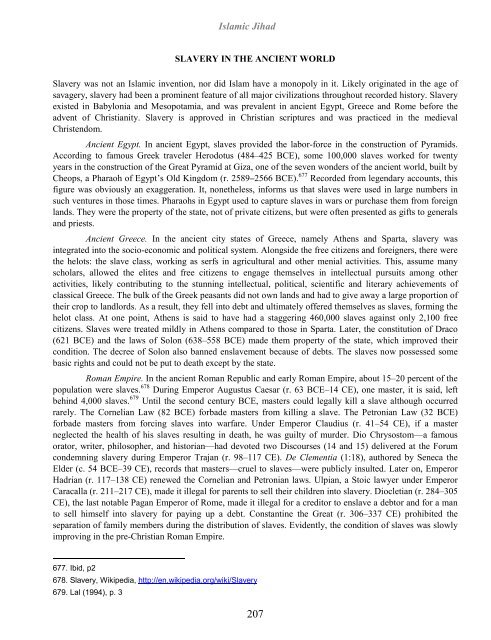islamic-jihad-legacy-of-forced-conversion-imperialism-slavery
islamic-jihad-legacy-of-forced-conversion-imperialism-slavery
islamic-jihad-legacy-of-forced-conversion-imperialism-slavery
- No tags were found...
You also want an ePaper? Increase the reach of your titles
YUMPU automatically turns print PDFs into web optimized ePapers that Google loves.
Islamic JihadSLAVERY IN THE ANCIENT WORLDSlavery was not an Islamic invention, nor did Islam have a monopoly in it. Likely originated in the age <strong>of</strong>savagery, <strong>slavery</strong> had been a prominent feature <strong>of</strong> all major civilizations throughout recorded history. Slaveryexisted in Babylonia and Mesopotamia, and was prevalent in ancient Egypt, Greece and Rome before theadvent <strong>of</strong> Christianity. Slavery is approved in Christian scriptures and was practiced in the medievalChristendom.Ancient Egypt. In ancient Egypt, slaves provided the labor-force in the construction <strong>of</strong> Pyramids.According to famous Greek traveler Herodotus (484–425 BCE), some 100,000 slaves worked for twentyyears in the construction <strong>of</strong> the Great Pyramid at Giza, one <strong>of</strong> the seven wonders <strong>of</strong> the ancient world, built byCheops, a Pharaoh <strong>of</strong> Egypt’s Old Kingdom (r. 2589–2566 BCE). 677 Recorded from legendary accounts, thisfigure was obviously an exaggeration. It, nonetheless, informs us that slaves were used in large numbers insuch ventures in those times. Pharaohs in Egypt used to capture slaves in wars or purchase them from foreignlands. They were the property <strong>of</strong> the state, not <strong>of</strong> private citizens, but were <strong>of</strong>ten presented as gifts to generalsand priests.Ancient Greece. In the ancient city states <strong>of</strong> Greece, namely Athens and Sparta, <strong>slavery</strong> wasintegrated into the socio-economic and political system. Alongside the free citizens and foreigners, there werethe helots: the slave class, working as serfs in agricultural and other menial activities. This, assume manyscholars, allowed the elites and free citizens to engage themselves in intellectual pursuits among otheractivities, likely contributing to the stunning intellectual, political, scientific and literary achievements <strong>of</strong>classical Greece. The bulk <strong>of</strong> the Greek peasants did not own lands and had to give away a large proportion <strong>of</strong>their crop to landlords. As a result, they fell into debt and ultimately <strong>of</strong>fered themselves as slaves, forming thehelot class. At one point, Athens is said to have had a staggering 460,000 slaves against only 2,100 freecitizens. Slaves were treated mildly in Athens compared to those in Sparta. Later, the constitution <strong>of</strong> Draco(621 BCE) and the laws <strong>of</strong> Solon (638–558 BCE) made them property <strong>of</strong> the state, which improved theircondition. The decree <strong>of</strong> Solon also banned enslavement because <strong>of</strong> debts. The slaves now possessed somebasic rights and could not be put to death except by the state.Roman Empire. In the ancient Roman Republic and early Roman Empire, about 15–20 percent <strong>of</strong> thepopulation were slaves. 678 During Emperor Augustus Caesar (r. 63 BCE–14 CE), one master, it is said, leftbehind 4,000 slaves. 679 Until the second century BCE, masters could legally kill a slave although occurredrarely. The Cornelian Law (82 BCE) forbade masters from killing a slave. The Petronian Law (32 BCE)forbade masters from forcing slaves into warfare. Under Emperor Claudius (r. 41–54 CE), if a masterneglected the health <strong>of</strong> his slaves resulting in death, he was guilty <strong>of</strong> murder. Dio Chrysostom—a famousorator, writer, philosopher, and historian—had devoted two Discourses (14 and 15) delivered at the Forumcondemning <strong>slavery</strong> during Emperor Trajan (r. 98–117 CE). De Clementia (1:18), authored by Seneca theElder (c. 54 BCE–39 CE), records that masters—cruel to slaves—were publicly insulted. Later on, EmperorHadrian (r. 117–138 CE) renewed the Cornelian and Petronian laws. Ulpian, a Stoic lawyer under EmperorCaracalla (r. 211–217 CE), made it illegal for parents to sell their children into <strong>slavery</strong>. Diocletian (r. 284–305CE), the last notable Pagan Emperor <strong>of</strong> Rome, made it illegal for a creditor to enslave a debtor and for a manto sell himself into <strong>slavery</strong> for paying up a debt. Constantine the Great (r. 306–337 CE) prohibited theseparation <strong>of</strong> family members during the distribution <strong>of</strong> slaves. Evidently, the condition <strong>of</strong> slaves was slowlyimproving in the pre-Christian Roman Empire.677. Ibid, p2678. Slavery, Wikipedia, http://en.wikipedia.org/wiki/Slavery679. Lal (1994), p. 3207


